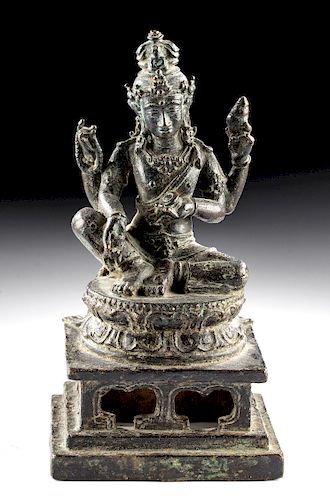18th C. Javanese Bronze Avalokiteshvara
Lot 129
About Seller
Artemis Gallery
686 S Taylor Ave, Ste 106
Louisville, CO 80027
United States
Selling antiquities, ancient and ethnographic art online since 1993, Artemis Gallery specializes in Classical Antiquities (Egyptian, Greek, Roman, Near Eastern), Asian, Pre-Columbian, African / Tribal / Oceanographic art. Our extensive inventory includes pottery, stone, metal, wood, glass and textil...Read more
Categories
Estimate:
$3,000 - $4,500
Absentee vs Live bid
Two ways to bid:
- Leave a max absentee bid and the platform will bid on your behalf up to your maximum bid during the live auction.
- Bid live during the auction and your bids will be submitted real-time to the auctioneer.
Bid Increments
| Price | Bid Increment |
|---|---|
| $0 | $25 |
| $300 | $50 |
| $1,000 | $100 |
| $2,000 | $250 |
| $5,000 | $500 |
| $10,000 | $1,000 |
| $20,000 | $2,500 |
| $50,000 | $5,000 |
| $100,000 | $10,000 |
| $200,000 | $20,000 |
About Auction
By Artemis Gallery
Sep 26, 2019
Set Reminder
2019-09-26 10:00:00
2019-09-26 10:00:00
America/New_York
Bidsquare
Bidsquare : Exceptional Day 1: Antiquities & Asian Art
https://www.bidsquare.com/auctions/artemis-gallery/exceptional-day-1-antiquities-asian-art-4437
Day 1 of an important 2-day auction featuring exceptional, museum-worthy examples of Egyptian, Greek, Etruscan, Roman, Viking, Russian, Near Eastern, as well as Asian Art from China, Japan, Thailand, Vietnam, Burma and India. Artemis Gallery info@artemisgallery.com
Day 1 of an important 2-day auction featuring exceptional, museum-worthy examples of Egyptian, Greek, Etruscan, Roman, Viking, Russian, Near Eastern, as well as Asian Art from China, Japan, Thailand, Vietnam, Burma and India. Artemis Gallery info@artemisgallery.com
- Lot Description
Southeast Asia, Indonesia (Java), ca. 18th to 19th century CE. A cast bronze votive figure of an important bodhisattva, Avalokiteshvara, "The Lord Who Gazes Down At The World". This bodhisattva if often portrayed as both male or female (here male), and embodies the compassion of all Buddhas. The figure is seated cross-legged on a delicate lotus throne, with each petal individually delineated; this is atop two tiers of a square-platformed pedestal with openwork sides. The figure has four arms, each holding a different implement: a bottle, a shell, a string of pearl beads, and a floral-shaped object. Atop the figure's head is a headdress topped with small Buddha heads. Size: 3.45" W x 6.45" H (8.8 cm x 16.4 cm)
The reason for this proliferation of heads and arms? One Buddhist story tells of how Avalokitesvara swore never to rest until they had freed all of the sentient beings on earth from the cycle of death and rebirth. However, the multitude of beings requiring saving overwhelms the bodhisattva, and so one of the Buddhas gives them multiple heads with which to hear the cries of the suffering. Reaching out after hearing them, Avalokitesvara's arms shatter, and so the same Buddha grants them thousands of arms.
Provenance: private Hawaii, USA collection; ex-private Hirsch collection, Germany
All items legal to buy/sell under U.S. Statute covering cultural patrimony Code 2600, CHAPTER 14, and are guaranteed to be as described or your money back.
A Certificate of Authenticity will accompany all winning bids.
We ship worldwide and handle all shipping in-house for your convenience.
#141194Excellent condition with well-preserved form and great deposits on surface.Condition
- Shipping Info
-
All shipping is handled in-house for your convenience. Your invoice from Artemis Gallery will include shipping calculation instructions. If in doubt, please inquire BEFORE bidding for estimated shipping costs for individual items.
-
- Buyer's Premium



 EUR
EUR CAD
CAD AUD
AUD GBP
GBP MXN
MXN HKD
HKD CNY
CNY MYR
MYR SEK
SEK SGD
SGD CHF
CHF THB
THB
















